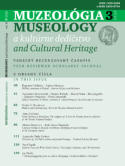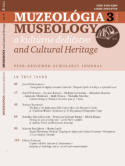

MUZEOLÓGIA
MUSEOLOGY
a kultúrne dedičstvo
and Cultural Heritage

News
Journal Muzeológia a
kultúrne dedičstvo -
Museology and Cultural
Heritage:
SJR 2024: 0,424 (Q1)
Museology SJR rank: 8/83 (Q1) Conservation SJR rank: 11/103 (Q1)JIF WoS 2024: 0,7
JCI WoS 2024: 1,25, Q1 ESCI: 40/408 (Q1)New issue
Muzeológia a kultúrne
dedičstvo 2/2025
online New volume Studia Museologica Slovaca, vol. 8 (2024) online New volume Populačné štúdie Slovenska 18 (2025) onlineNew book
L. Jagošová a P. Tišliar (eds.). Kapitoly z dějin uměleckoprůmyslového muzejnictví (2025) online
Contents 3/2021
Title: Avant-garde art display recreations historised: Muzeum Sztuki in Łódź as a referential case?
Abstract: Museums can no longer pretend to be mere containers of art or other cultural treasures; their fascinating legacy for posterity
is definitely not just the respective collection, but also its idiosyncratic articulation and ulterior resignification. This essay surveys sifting
trends in the re-staging of modern museographies; but instead of using New York’s MoMA as the obvious paradigm, pride of place is
given here to the Muzeum Sztuki in Łódź (Poland). Its original Neoplastic Hall survived only from June 1948 until October 1950; but it
was reconstructed ten years later, prefiguring other museographical remakes of avant-garde art displays. Thereafter, it also became, in
many ways, a typical example characterising postmodern museological trends. All in all, it could perhaps be discussed nowadays in
the light of critical museology as a referential case in the history of heritagised museographies.
Author: Jesús Pedro Lorente
Publication order reference: University of Saragossa, Department of Art History, Spain, e-mail: jpl@unizar.es, ORCID: 0000-0003-
4500-5182
Source: Muzeológia a kultúrne dedičstvo, year: 2021, vol.: 9, number: 3, pages: 5-15.
Key words: museographical reconstructions, museum history, critical heritage studies
Language: English
online full-text PDF
DOI: 10.46284/mkd.2021.9.3.1
Title: Cultural heritage of Poland in the urban space of Vienna
Abstract: The aim of the research was to define the cultural heritage of Poland as represented in the urban space of Vienna by
Polonica. Structures commemorating Poles or events they took part in, as well as places related to Poland and Polish people such as
Nazi death camps, or geographical objects, were included. Polonica were grouped and analysed in terms of the time of creation,
location in the city space, founders, inscriptions and building materials (if they came from Poland). On the basis of the results and
discussion, it was found that, as a group of objects, Polonica represent the cultural heritage of Poland from various periods. These
objects show both the history of the people and events commemorated, as well as events in the history of Poland over the last 400
years. Moreover, it was argued that some Polonica constitute the cultural heritage of both Poland and Austria. Some objects may be
perceived and interpreted differently, which may be related to international political disputes.
Authors: Karol Witkowski, Szymon Kowalik, Barbara Czerwińska, Aleksandra Kędzior, Agnieszka Obermajer, Jakub Pałucki,
Weronika Sikorska
Publication order reference: Pedagogical University of Krakow, Institute of Geography, Krakow, Poland, e-mail:
karol.witkowski@up.krakow.pl, ORCID: 0000-0002-0910-9374; e-mail: szymon.kowalik@up.krakow.pl, ORCID: 0000-0002-3941-6818;
e-mail: barbara.czerwinska@student.up.krakow.pl, ORCID: 0000-0002-5144-4168; e-mail: aleksandra.kedzior@student.up.krakow.pl,
ORCID: 0000-0002-6192-8238; e-mail: agnieszka.obermajer@student.up.krakow.pl, ORCID: 0000-0002-1137-998X; e-mail:
jakub.palucki@student.up.krakow.pl, ORCID: 0000-0003-1105-0292; e-mail: weronika.sikorska@student.up.krakow.pl, ORCID: 0000-
0002-6045-8107
Source: Muzeológia a kultúrne dedičstvo, year: 2021, vol.: 9, number: 3, pages: 17-41.
Keywords: Polonica, cultural heritage, history of Poland, Vienna
Language: English
online full-text PDF
DOI: 10.46284/mkd.2021.9.3.2
Title: The Role of the Kolbuszowa Folk Culture Open-Air Museum in Studies of Traditional Wooden
Architecture of the Rzeszowiacy Ethnographic Group
Abstract: Province, which is located in the south-eastern corner of Poland. At the beginning of the 1970s, as the result of an initiative
drawing attention to the need for documentation of the rapidly disappearing traditional Rzeszowiacy vernacular wooden architecture
(and that of the neighboring ethnographic group, the Lasowiacy), the Folk Culture Open-Air Museum in Kolbuszowa was created. This
paper presents a short overview of the open-air museum’s establishment and describes in detail its role in the study and protection of
the wooden architectural heritage of the Rzeszowiacy ethnographic group, based on the museum’s research, carried out over fifty
years, and its collection of buildings.
Author: Tomasz Tomaszek
Publication order reference: University of Technology Rzeszow & Regional Architecture Documentation Studio the Folk Culture
Open-Air Museum in Kolbuszowa, Poland, e-mail: ttomasz@prz.edu.pl, e-mail: architektura@muzeumkolbuszowa.pl, ORCID: 0000-
0003-3529-7775
Source: Muzeológia a kultúrne dedičstvo, year: 2021, vol.: 9, number: 3, pages: 43-63.
Keywords: wooden vernacular architecture, Rzeszowiacy ethnographic group, open-air museum
Language: English
online full-text PDF
DOI: 10.46284/mkd.2021.9.3.3
Title: Heritage of (non-)existing cities – on the Polish examples of medieval Świecie and Renaissance
Krasiczyn
Abstract: This article analyses the urban heritage protection and spatial development policies of two model historical urban centres in
Poland, whose spatial layout has been erased: medieval Świecie nad Wisłą (the Pomeranian region) and Renaissance Krasiczyn (the
Subcarpathian region). Their urban layouts had a significant compositional factor (a town and castle complex in axial plan). The
second element important in terms of landscape protection and spatial planning is their history: at the end of the eighteenth century
and during the nineteenth century they had to be relocated. The analysis covers the spatial form during the period of their founding,
the reasons for transformation, their present-day state of preservation, and the current spatial conservation and development policy.
General conservation conclusions have also been formulated.
Authors: Karolina Zimna-Kawecka, Dominika Kuśnierz-Krupa, Michał Krupa
Publication order reference: Nicolaus Copernicus University, Toruń, Poland; Cracow University of Technology, Poland, e-mail:
kzimka@umk.pl, ORCID: 0000-0002-9612-8038; e-mail: dkusnierz-krupa@pk.edu.pl, ORCID: 0000-0003-1678-4746; e-mail:
michal.krupa@pk.edu.pl, ORCID: 0000-0002-2199-0598
Source: Muzeológia a kultúrne dedičstvo, year: 2021, vol.: 9, number: 3, pages: 65-92.
Keywords: Świecie, Krasiczyn, urban layout, heritage, protection, revitalisation, Poland
Language: English
online full-text PDF
DOI: 10.46284/mkd.2021.9.3.4
In Practice
Title: Spatial Distribution Model for Targeting the Support for Cultural Institutions’ Development: A
Case Study of Slovakia
Abstract: Culture is one of the main tools for developing regions and reducing regional disparities. It is a significant job creator; it
participates in social cohesion representing a catalyst for economic growth. In practice, when boosting the potential of cultural and
creative industries, we encounter an insufficiently developed approach to evaluating the initial conditions for the allocation of financial
resources for its development. This paper’s objective is to identify, map, and analyse spatial concentration of cultural institutions in
Slovakia. The intention of the analysis was the identification of regions and districts with the potential for full use of cultural capital as a
tool for sustainable regional development as well as the setting of cultural policy. The cluster analysis pointed out significant
differences in the representation of cultural institutions in individual regions and districts of Slovakia. The regions with the most
desirable results (e.g., Bratislava, Trnava, or Nitra) have some common characteristics linked to the local context, such as historical
development, good infrastructure, concentration of educational institutions. The results also confirmed the assumption that within the
regions, cultural institutions will be concentrated in larger district cities, specifically in the case of Bratislava even inside the city. From
the cluster analysis it is possible to observe a “belt of districts” of Southern, Central, and Eastern Slovakia, which do not have sufficient
cultural infrastructure. Since the process of shaping the supportive policy for cultural industries is now ongoing in Slovakia, we
consider mapping the situation as one of the key elements in the policy-making process.
Authors: Kristína Baculáková, Martin Grešš
Publication order reference: University of Economics, Bratislava, Slovakia, e-mail: kristina.baculakova@euba.sk, ORCID: 0000-
0002-0143-7541; e-mail: martin.gress@euba.sk, ORCID: 0000-0003-1655-043X
Source: Muzeológia a kultúrne dedičstvo, year: 2021, vol.: 9, number: 3, pages: 93-112.
Keywords: spatial differentiation, cultural institutions, cluster analysis, regional development, Slovakia
Language: English
online full-text PDF
DOI: 10.46284/mkd.2021.9.3.5
Title: Leopolis collection, Museum of Independence – wellspring of knowledge, state of research and
recommendations
Abstract: The Leopolis Collection (at the Museum of Independence) constitutes a valuable source of knowledge on the past of Lviv
and its surroundings as well as the fate of the Polish people living there. Created in 1992 as a result of the efforts of Borderland
circles, its contribution is used for research by museum specialists, professional historians and researchers of the Borderlands past.
The artefacts, archival materials and publications collected there are made use of for preparing exhibitions, scholarly articles and
monographs.
These valuable collections in relation to exhibitions are still awaiting a systematic study. Research undertaken so far has borne fruit in
the form of valuable monographs and studies, but there are many valuable materials still waiting to be unearthed. For the purposes of
accessing the museum materials the creation of a Leopolis Collection catalogue is necessary so that its contents can be more broadly
made use of – both in historical research and that pertaining to museum-based studies.
Author: Jolanta Załęczny
Publication order reference: Academy of Finance and Business Vistula, Warsaw, Poland, e-mail: j.zaleczny@vistula.edu.pl, ORCID:
0000-0003-0615-410X
Source: Muzeológia a kultúrne dedičstvo, year: 2021, vol.: 9, number: 3, pages: 113-131.
Keywords: museum collection, Borderlands, Museum of Independence, Museum Studies, historical awareness, Lviv
Language: English
online full-text PDF
DOI: 10.46284/mkd.2021.9.3.6
Articles (Abstracts)

Full-text version
DOI:10.46284/mkd.2021.9.3.0
ISSN 1339-2204
eISSN 2453-9759
Vol. 9 (2021), No. Is. 3



























